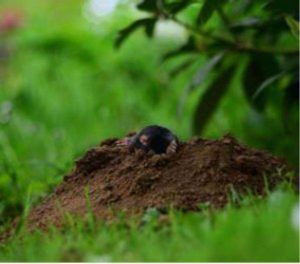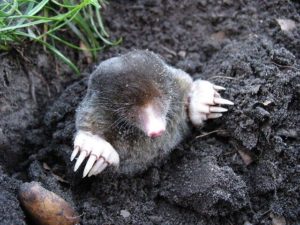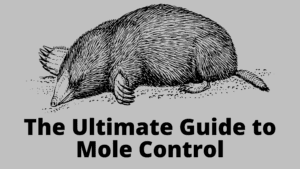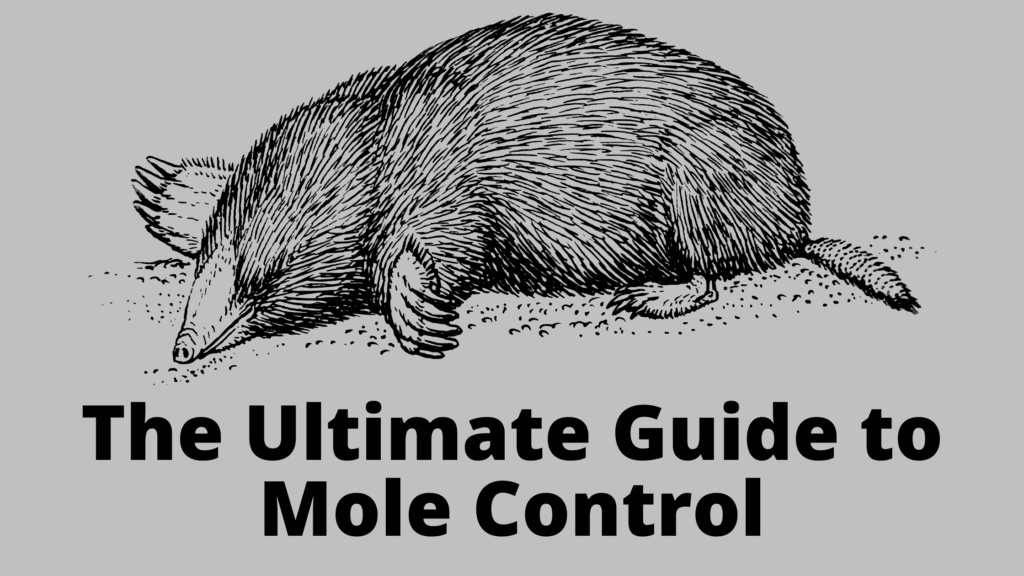Yard pests such as moles are noticeable and hazardous to your yard and safety as a person. Imagine hosting a barbecue with neighbors and having Karen sink into a tunnel, trip, and threaten to sue you. That’s no good!
Thankfully there are methods of control that you can take to regain control of your yard! Learn all about moles, their habits, breeding, and how they damage your yard. Learn how to take back control of your yard with different methods like traps, gasses, baits, repellents, and natural options.
Finally, learn how we treat humanely for these yard pests, leaving you with peace of mind and confidence to show off your mole-free yard!
Table of Contents
Moles
 Most have ideas in their mind of what moles look like: short stubby legs with large claws perfect for digging; cylindrical grey bodies with velvety fur to slide through their tunnels; indistinguishable eyes and ears, but a predominate snout for consuming grubs.
Most have ideas in their mind of what moles look like: short stubby legs with large claws perfect for digging; cylindrical grey bodies with velvety fur to slide through their tunnels; indistinguishable eyes and ears, but a predominate snout for consuming grubs.
Female moles are called sows and male moles are called boars, but a group of moles isn’t called swine, it’s called a labour. However, moles are typically solitary creatures, only found in groups for mating purposes.
Shrews are kind of like an outdoor mouse, but they are the mole’s closest relative, perhaps a cross between a mouse and a mole. Vole activity gets mistaken for mole activity, and they can inhabit mole tunnels as well.
While moles are mammals that breathe oxygen, they are actually the only mammal that has a specific type of hemoglobin in their blood cells that gives them an affinity to take in more oxygen in different forms, like carbon dioxide. These creatures reuse their breaths many times allowing them to breathe just fine under low oxygen areas like burrows and tunnels.
Fun fact: moles’ velvety fur has no particular nap, or direction with which the hair lies. This also serves them well as it allows them to travel quickly backward or forward in their tunnels.
Moles are unique animals with polydactyl limbs: they sometimes have an extra thumb next to their normal thumb on their claws. Their other digits also have more joints than those of human hands.
Moles are fascinating hunters of earthworms, their primary diet. Moles dig their tunnels as a construction of underground highway system, but they also create burrows where they sleep and larders, an underground area where moles keep their food.
Because moles have a toxin in their saliva that paralyzes earthworms, moles can simply cover the earthworm in saliva and store them for later eating. Researchers have found larders with over 10,000 earthworms! And I never really thought of moles to be the type of animal to store up food.
Moles also have a unique sense of hearing, smelling, and vibration. So much so that their tunnels are actually just worm traps, as moles can sense when an earthworm has fallen into its tunnel and scurries along to eat it or paralyze it and store it for later.
Fun fact: moles don’t eat dirt, they actually don’t like the taste because before they eat an earthworm, they pull, stretch, and squish the worm so all of its consumed dirt is out of its intestines.
There are different types of moles too, like: golden moles, marsupial moles, star-nosed moles, and Eastern moles; Townsend moles (endangered in the US and Canada) and Coast moles. Eastern moles are common in Europe and North America, prevalent in the United States.
For other wildlife tips and tricks, check out this category within our blog.
Breeding
Since moles are typically solitary creatures, they do find one another during mating season. Between the months of February and May, male moles seek out female moles. They do so by producing a high-pitched squeal while traveling into foreign areas.
Gestation period lasts about 42 days and between 3 to 5 babies are born per litter. And the young pups leave their litters, located within burrows, between 30 and 45 days after they are born.
Between April and May mole activity begins to pick up for these reasons: new life and warmer weather.
Yard Damage
Moles do not eat plants or roots. They only eat grubs, earthworms, and other invertebrates in the soil underneath the grass.
They cause damage to lawns, gardens, crops, etc. indirectly, as a result of their digging for grubs.
While moles are a nuisance, they have been proven to be a help in 2 main ways. Moles eat things that eat roots of your plants and grass. And by way of their tunnels they can aerate the soil nicely, it can just be a pain to remove moles and level their tracks.
Did you know moles are protected in Germany? They can only be killed with a permit.

Wondering about vole vs mole activity? These are mole hills.
Activity
If you’re looking for information on vole vs mole situations, keep reading. Moles and voles are very often confused. Most often people call with the information that their yard is getting destroyed with something.
Gophers and voles are commonly mistaken for moles. But gophers and voles eat plant roots and bulbs. It’s important to be able to tell the difference.
Voles and gophers travel along little paths they create in your lawn. So if you have tiny trails of worn down grass that looks like something travels there, you have either voles or gophers. These pests go after the roots and bulbs of plants and grasses in your yard.
Moles are small and are rarely seen above ground. Most folks realize they have moles based on the activity they leave: trails of raised ground, spots in your yard where you sink in when you step, and little mounds that look like tiny volcanoes are common mole activity areas.
While voles burrow underground, they never leave any hills or mounds of dirt, so mounds of dirt is one of the easier tells. Vole vs mole activity can be hard to tell. Voles have more trails through your yard, while moles have sinking down tunnels throughout your yard.
Moles are year-round pests, able to withstand cold temperatures and simply dig deeper (down to 30 feet) to stay warm for Minnesota winters.
Having learned that moles are solitary creatures you may think your disrupted yard may be the cause of one mole. This is not often the case. Simply, moles create territories underground and restrict access to other moles. This is why there can be many moles disrupting your yard.

Methods of Mole Control
Some repellents and products you can buy over-the-counter may work on one or all three (moles, voles, and gophers) of these yard pests, but it is important to differentiate what type of pest you have.
In this section we will briefly go over different methods of control like traps, gasses, baits, repellents, and natural options. You can learn how to remove moles from your yard and how to get rid of moles fast.
Mole control can be a tough issue to tackle and it is important to consult a pest management profession before trying something dangerous or if your methods have not worked.
Keep in mind mole control is a balance between eradication and then prevention. When it comes to wildlife services there isn’t always the ability to eradicate pests and a good control measure is needed.
Fun fact: moles, like every other mammal, cannot digest chewing gum. If you’d like to try this method of mole control, we would recommend the Hubba Bubba clamshell variety, because it looks more worm-like than the blocks.
Traps for Mole Control
Controlling moles with traps is a fairly straight forward approach. You can purchase different types of mole traps at any home and garden store.
One example of a mole trap is a metal trap that you can plunge into a mole tunnel and set. When the mole comes into contact with the trap and it goes off, the mole will be impaled and you simply dig out the mole and trap, remove and dispose of the carcass, and reset the trap.
Metal traps can be a good mole control technique if you can handle the work.
Another example of a mole trap is a safe box-like trap you can place underneath the mole tunnels. This one takes a bit more work as you have to dig around the tunnel and place it underneath the track. When a mole scurries over that area of the tunnel, it will fall into the box and you can relocate the mole a safe distance from your yard.
There are always ways you can create DIY traps like this last method, but most of them take quite a bit of time and thought. Then, execution has to be perfect. Finally, you will usually have to repeat the steps for however many moles your yard has.
Gasses for Mole Control
Calcium carbonate is an example of a gas that, when emitted into a mole tunnel, will kill moles. This can come in the form of tablets to place in mole tunnels.
Phostoxin or Talunex tablets which emit aluminum phosphide will also kill moles when placed into a mole tunnel.
We do not recommend either of these options, especially if you have pets or children.
Carbon dioxide is harmful to moles if breathed for too long. Because of their special hemoglobin in their blood stream, moles can breathe in higher counts of oxygen. They can live longer from breathing oxygen in different forms.
If you wanted to try to pipe carbon dioxide from your car or truck exhaust into mole tunnels, it should kill them. It may take some time and would require the proper hosing equipment and leaving your vehicle running for several minutes to an hour depending on how large your yard is and how many mole tunnels there are.
We don’t recommend this option simply because it would be a hassle to move the vehicle around if the hose isn’t long enough and because running your vehicle for too long can produce carbon monoxide, which is deadly.
We would only recommend the carbon dioxide option if you have a controlled approach to implement this treatment. Carbon dioxide treatments, when implemented seamlessly, are a surefire way to get rid of moles.
Baits for Mole Control
Many folks, as well as pest control companies, choose this option to treat for moles. It is simple to purchase a brand like Tomcat earthworms or Tomcat grubs, which are over-the-counter baits.
Most pest control companies will use these or stronger baits to attract moles. But the process is the same: dig into the mole tunnel, place the worm-like bait, cover up, and wait for the mole(s) to consume the poison bait.
Baits have been known to be effective, but we don’t recommend this option if you have pets that like to dig in your yard. If a pet consumed this bait, it could die. Even if a pet ate a mole, there is high risk for secondary transfer of the poison because the mole’s liver stores the poison.

Repellents for Mole Control
Castor oil can be an effective repellent to keep moles out of your yard.
Castor oil can be purchased at a local home and garden store and will usually come with a garden hose attachment.
Simply follow the directions on the bottle and spray around your yard. Castor oil can have an effect on the worm and grub population. Making moles’ food source scarce increases the likelihood that they will pass by your yard in search of food.
Castor oil also doesn’t taste or smell good to moles, so it can also have an effect on your yard if moles are already living in there, though it works best if applied as a repellent prior to any start of activity.
Castor oil disrupts moles’ and gophers’ digestive tracts and makes your yard less appealing to them. Take away the food source and make your yard less appealing is the perfect preventative approach!
Keep in mind that castor oil may damage some plant life in your yard, so use with care if you try this option.
For other yard pests, check out this category within our blog.
Natural Options for Mole Control
Some choose to try a more natural approach, like with garlic oil, or citronella oil. You can purchase essential oils, mix with water, and treat your yard this way. Since moles don’t like the taste or smell of garlic, you could simply cut up some cloves and place into their tunnels.
You could also plant garlic, onion, and other flowering plants that moles don’t like the smell of.
Ultrasonic wave devices emit high-pitched noises that moles cannot stand, because they are dependent on sounds and vibrations over sight. You shouldn’t use this option if you have pets, as they can hear these decibels that humans cannot.
These noise emitting devices can be purchased at a local home and garden store and are fairly simple to install. Repellents like these can work for mole control.
Liquid repellents are often mixed with dish soap or other commonly used household materials, but these options are the most complicated methods to use and are rarely effective because of this. If the ratio of product to dish soap is off it may be ineffective or damage your lawn and garden.
Liquid repellents can work for mole control.
If you would like to take a natural, yet extreme, approach, HGTV offers a unique approach of installing a 15-20-foot post in your yard with a 2 inch roosting spot near the top.
Hawks, eagles, and other flying predators will eventually land there to scout out a food source and when the mole(s) sense this predator lurking, they should go elsewhere. If not, they will be eaten by nature. Though they may not taste as good as a mouse to a hawk or owl, it could be lunch.
Another natural option is burying your pet’s waste in the mole tunnels or hills, this will definitely help deter them. Or coffee grounds, as gophers and moles don’t like the scent of coffee grounds either.
Sometimes getting rid of the food source (grubs) can be messier for you. Moles may create many more tunnels in search of a food source before retreating to another’s yard, leaving you with a mess to clean up, tunnels to stomp down, and molehills to fill in.
We recommend that if you treat moles on your own using any of these methods, that you also stomp down the mole tunnels and hills after a few days to target any new activity and track progress in that way.
Will moles go away on their own? No, they need to be treated or removed from your yard.

For additional tips and tricks and DIY pest control options, check out our category within our blog.
How We Treat
Done Right Pest Solutions is familiar with the baiting technique, but we feel that it is not a long-term solution. Moles often invade from wooded areas or neighboring lawns and you can’t control if your neighbors get pest control.
Baits can also be harmful to pets that could dig in your yard.
For these reasons we have taken a different approach to mole control: machine controlled emissions of carbon dioxide.
We have a machine that we wheel around on a 2-wheeler and it comes with 2 hose attachments making it perfect to treat small yards and large yards alike.
Our technicians start by feeding the hose into a mole tunnel and turning on the machine. Another technician or assistant will find the other end of the hole where the carbon dioxide fog is protruding and cover it up.
After letting it sit the proper amount of time for any moles underneath to have died, they move on to the next tunnel. While that tunnel is filling up, the assistant will stomp down the tunnel of the first one for you. This way, if you see any more tunnels pop up you know you have fresh activity.
This process is repeated until the whole yard has been treated and tunnels have been stomped down.
We offer one-time service options and continued service rates (which are kind of like touch ups as they don’t take as long and are lower in cost than the first service.
Conclusion & Next Steps
From this Ultimate Guide to Mole Control you have learned all about these underground mammals, their habits, breeding, and the damage they make to your yard. From the damage these pests leave on your yard, you learned how to spot activity, how to tell the difference between moles, voles, and gophers.
There are different methods of mole control including traps, gasses, baits, repellents, and natural options. You learned some brands, options, and our recommendations for each. We shared some tips and tricks for how to track treatment progress with either option you choose.
Finally, we shared an explanation of how we treat moles using our machine controlled emissions of carbon dioxide. We feel that this is the safest approach to treat a yard for mole activity as it will not harm any children or pets. We also know that this is the most humane way of treating moles as they simply fall asleep.
Our one-time mole service and continued services are complete with leveling of mole tunnels and a warranty.
If you are feeling overwhelmed with your options and want a pest control expert to handle these pesky yard pests for you, call Done Right Pest Solutions today! 651-342-9489.
We would love to help your yard get back to normal.
Done Right Team
P.S. While our mole services aren’t included in our Peak Seasons Plan, we do offer discounts to any annual client who also wants mole services.
Have you had moles before and used any of these options? If so, tell us your experience below. We love to hear first-had accounts of what works for you!
Want to learn more in-depth guides to pest control techniques? Or maybe simple tips and trick tailored to fit your needs? Sign up for our free email newsletter!

